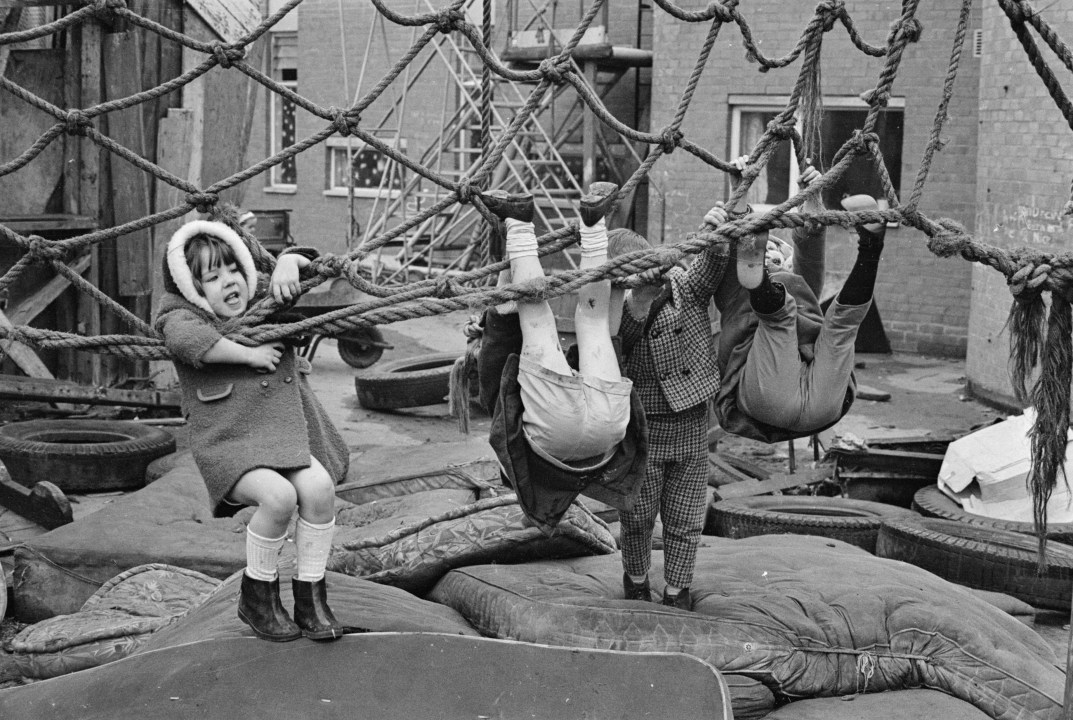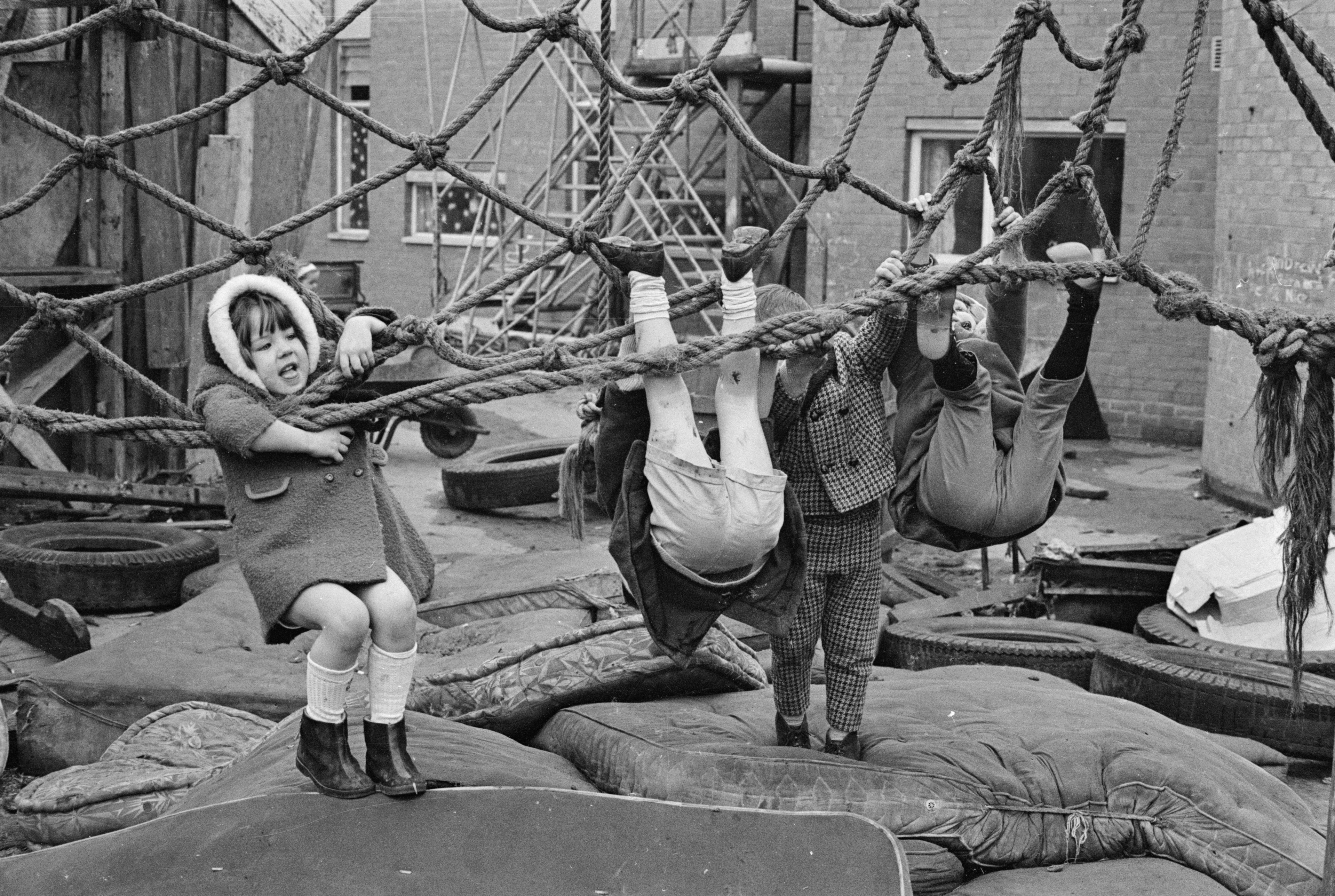Mud, timber, junk, fires, splinters, rust, daubed paint… Suddenly people are talking about adventure playgrounds again. With the Turner Prize-nominated collective Assemble constructing a new adventure playground in Glasgow, and their exhibition The Brutalist Playground at Riba, we’re being asked to think again about these ugly but lovable spaces.
It was the landscape architect Lady Allen of Hurtwood who saw that in these gloriously chaotic environments — with their dens, walkways, animals, zip wires and cargo nets — children could find a freedom, self-expression and self-determination that is denied to them elsewhere.
In 1946, on the way to Norway for a lecture tour, Lady Allen’s plane stopped to refuel in Copenhagen. Here, she encountered the junk play gardens set up by Danish landscape architect Carl Sorensen in a newly built housing estate in Emdrup.
‘I was completely swept off my feet,’ she wrote. ‘In a flash of understanding I realised that I was looking at something quite new and full of possibilities. There was a wealth of waste material… and no man-made fixtures. The children could dig, build houses, experiment with sand, water or fire, and play games of adventure and make-believe.’
Sorensen admitted it looked pretty squalid: ‘Of all the things I have helped to realise, the junk playground is the ugliest; yet for me it is the best and most beautiful of my works.’ The playground resonated with Lady Allen’s memories of her bohemian country childhood and her conviction that children needed ‘the chance to work out their own kinds of play’.
Back in England, she threw her weight behind the creation of the Clydesdale Road adventure playground in Kensington, which opened in 1952. Over the next two decades, the model was replicated in inner-cities in Liverpool, Hull, Coventry, Leeds and Bristol, and hard-wired into new towns such as Welwyn. By the 1970s there were nearly 500 adventure playgrounds in the UK. Today, there are fewer than 150.
In a period that saw the construction of untold numbers of municipal playgrounds — swing, slide and see-saw planted in a dead sea of Tarmac — adventure playgrounds stand out as a distinct typology. While the conventional playground promoted kinetic play, the adventure playground allowed the child the pleasures of testing, inventing, making and destroying. Filled with junk and waste materials, these are environments made and remade by the children themselves.
A key feature was the presence of the playworker, who being neither teacher, parent nor policeman, was described as ‘a grown-up who can help but won’t “boss”’.
The adventure playground’s roots lie in Nazi-occupied Denmark where, in the words of Lady Allen, ‘in the moral confusion of German occupation the difference between sabotage and delinquency was not obvious, and many of the children had become unruly and antisocial’. The success of Emdrup lay in its negotiation of this line between ‘sabotage and delinquency’. It fought fascism, on the one hand (the first Danish playworker was a member of the resistance), and helped enforce social order, on the other. ‘The permissive atmosphere in the playground provided a safe and creative simulation of lawlessness, where children could regain the trust in society through their engagement with a play leader who acted as their advocate and took their side,’ wrote Roy Kozlovsky, author of The Architectures of Childhood.
The war awoke fears of the chaos within the child — indeed, of the wasteland within us all. But when the bombing was over, the sight of children emerging from shelters to play amid the rubble became a powerful metaphor for reconstruction and renewal. Art therapist Marie Paneth proposed a play centre on a bomb site, arguing: ‘It could have a very healing effect if one were allowed to build upon the very spot where damage has been done.’
Come the 1960s, the focus of adventure playgrounds became the improvement of inner-city living conditions. ‘It was part of a political effort to go into poor communities to help organise and build,’ says the architectural historian Ken Worpole.

From the outset, an acceptance and exploration of risk had been at the heart of the adventure play experience, as expressed by Lady Allen’s rallying cry: ‘Better a broken bone than a broken spirit.’ Then, in 1974, came the Health and Safety at Work Act. Although adventure playgrounds had a remarkably good record for safety — the designer Ken Garland, another veteran of the adventure playground, recalls ‘nothing worse than a sprained wrist or a stubbed toe’ — the legislation eroded its legal and psychological basis. ‘It was not because of what the act actually said but because of the way people sought to misapply or misinterpret it,’ explains Tony Chilton, a pioneer playworker. ‘A number of local authorities used the act as an excuse for withdrawing support for adventure playgrounds, because of so-called safety issues.’
At the same time, adventure playgrounds were slowly subsumed within an expanding state-sponsored childcare system. Camden council demolished its adventure playgrounds and replaced them with subscription-only after-school clubs with fixed equipment. From 1998, there was the advent of Sure Start, with its children’s centres that sought outcomes like reducing obesity. Joyless targets had supplanted fun.
But a further twist of fate awaited adventure playgrounds. In recent years, already squeezed to the margins, their spirit has been stolen by playground designers and equipment manufacturers turning out designed versions of adventure play equipment, exploiting the junkyard aesthetic but stripping it of its child-led creative process.
Which brings us back to the renewed interest in adventure playgrounds. Where is this coming from? For architects and activists it’s a tactical means of reclaiming cities from property developers and repurposing land for social good. For competitive middle-class parents, it’s about a crisis of confidence. Was it so clever of us to eradicate all risk from our children’s lives so that now the only place for them to go truly wild is on the internet? The irony is that, while parents strain every sinew to keep their children safe from damage, that safety itself is stifling the development of children.
Is the answer simply to build more adventure playgrounds? The short answer, of course, is yes: for deep play, communal exuberance and pure recalcitrant joy, the enduring appeal of the adventure playground is hard to beat.







Comments